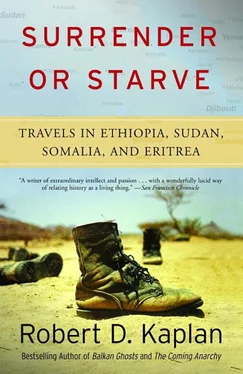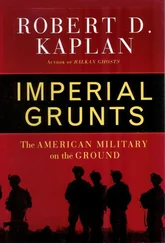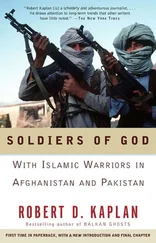The truth was that many in the Western community in the Ethiopian capital, who served as the West’s eyes and ears during the famine and provided the media with much of their information, did not want to admit the truth. Whatever nightmares the word “Ethiopia” may have conjured up in the United States, “Addis” was a nice place to be. (The same could not be said about capitals elsewhere in Africa, where the suffering in the countryside was far less.) The mountain climate was only partly responsible for the pleasant ambiance. As the headquarters of the Organization of African Unity, the Ethiopian capital was relatively clean, with good roads, a plethora of new public buildings, and well-manicured parks. The Hilton Hotel was one of the best-managed, centrally located Hiltons in the world; the Hilton’s heated, outdoor swimming pool served as a magnet for the foreign community on weekend afternoons.
As for the food, millions may have been starving in the adjacent countryside, but for foreigners, “Addis” was one of the better places on the continent to eat: a well-prepared charcoal-broiled steak, Nile perch, and Italian and Chinese cuisines always were available. Not only was the Hilton equipped with several fine restaurants, but around the city there were several more. No nearby, heartrending scenes spoiled the repasts; just as walls of stone blocked off the sinister reality of the Dergue, walls of corrugated iron blocked off the equally unpleasant reality of the slums. Nor were there many beggars in Addis Ababa; far less than in Egypt, for example, where nobody was starving. Christopher J. Matthews, in his article in The New Republic (January 21, 1985), made one of the most insightful observations ever about Ethiopia’s capital: “In a country where millions were starving, there was no sign of anyone begging or hustling to survive. I began to wonder. The price of coming into town must be higher than the price of staying away. If the price of staying away in the barren, dying parts of the country is near-certain death, the price of coming into the city must be even more terrible, even more certain.”
Matthews, perhaps without being aware of it, had stumbled close to the central fact of 1980s Ethiopia, a fact that many foreigners who actually lived there and many of the journalists who interpreted the famine for the public failed utterly to grasp— Ethiopia, in the manner of Syria and Iraq, was a modernizing and controlled, praetorian police state, with a single tribe or ethnic group on top, supported by the most brutal and sophisticated means of repression. For the officers in charge, preserving the integrity of the empire against rebels was a far more uplifting and important goal than fighting a famine was. The Soviets, the only great imperialists of the nineteenth century to have survived the twentieth, understood this. They helped, through massive arms shipments, the Dergue achieve its more important goal; the United States helped in the less important one.
As Matthews perceived, like the walls around the palace and around the slums, there was a wall around the famine, too. Destitute peasants were rounded up and arrested even before reaching the city limits. While Eritreans, Tigreans, and others in the northern provinces died by the hundreds of thousands, the markets of the Amhara fortress of Addis Ababa were brimming with grain. The price of it may have risen dramatically, but at least it was there. In Asmara, too, the government-held, fortified provincial capital of Eritrea, food was abundant because it was strategically necessary for the regime to keep the local population pacified. According to a confidential report by a Western relief agency, the “dedicated and efficient” RRC was virtually starving the worst famine regions in Wollo, while at the same time pouring food into embattled, militarily vital areas of Tigre and Eritrea and stockpiling it outside Addis Ababa. (Although in the first six months of 1985, Ethiopia got, more or less, all of the 750,000 tons of grain it required for that period through foreign donations, in Wollo the RRC distributed only about one-quarter of the grain allocated to that area.)
The sanitized reality of the Ethiopian capital, a condition that only the most chillingly brutal of regimes could create, helped make the place especially attractive for its foreign residents. “Addis” was a plum posting for a relief official. The situation in the country was “absolutely horrifying” and thus “in the news,” which translated into prestige and career advancement for those on the scene. Few seemed to want to rock the boat when rocking the boat could get you thrown out. In the Hilton lobby, it was easier to criticize the Reagan administration than it was to criticize the Dergue.
In 1921, the nascent Bolshevik regime in the Soviet Union was shaken by a great famine that its own ruthless policy of crop requisition had caused. Foreign aid was essential, and the U.S. people proved to be the most generous. Herbert Hoover, who seven years later would be elected president of the United States, spearheaded an effort that put food in the mouths of more than 12 million peasants. The regime survived to inflict an even greater famine in the following decade.
But in Ethiopia and in the United States, nobody paid attention to this legacy. In the February 7, 1985, report on the famine, issued by the Senate Subcommittee on Immigration and Refugee Policy and arising out of Senator Kennedy’s Christmas 1984 visit to the emergency feeding camps, six previous famines were listed in a table entitled, “Famine in Modern History.” The famines in the Ukraine, which were the largest of all, were not included in the list.
The mid 1980s Western relief effort in Ethiopia, like the one more than sixty years earlier in the Soviet Union, was idealistically conceived and succeeded at saving, for the time being, an uncountable number of lives. To some extent, turning the other cheek in the face of an ugly reality was necessary to achieve this. (One also could argue the opposite.) However, it is undeniable that the latter effort was far more critical to the survival of Mengistu than was Hoover’s to the survival of Lenin and Stalin. If we are to believe Dawit after his defection, the effort was absolutely crucial to the continued existence of what today has become the People’s Democratic Republic of Ethiopia, whose future, foodwise, appears even bleaker than its past.
The problem with the policy based solely on relief was that it ignored so much else of the drama in Ethiopia. What was ignored, although less visually stirring, was more central to Ethiopia’s future. But U.S. attention was kept focused on a thin and exposed stratum of reality.
Although there was one famine in Ethiopia, its estimated eight to ten million victims were divided up, in terms of responsibility, among three major armies and other minor ones in the warring north of Ethiopia. Outside of the main towns, most of Eritrea and Tigre were in the hands of antigovernment guerrillas: the Eritrean People’s Liberation Front (EPLF) and the Tigre People’s Liberation Front (TPLF), each with its own famine relief organization whose declared purpose was the same as the RRC’s. With troops constantly on the move, and mass migrations of peasants in progress, it often was impossible to know exactly how many starving people were in the territory of any one army at any particular time. As few as one-third, or as many as two-thirds, of those starving could have been in areas held by the EPLF and the TPLF on a given day. A common assumption was that almost half of the eight to ten million affected peasants were in territory reached only by guerrilla relief agencies. For journalists, this meant that the Ethiopian capital of Addis Ababa was a useful base for covering one side of the famine only. The base for covering the other side was Khartoum and the squalid Sudanese settlements near the border with Eritrea and Tigre.
Читать дальше












